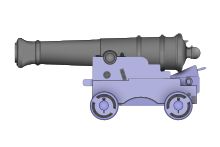| 30-pounder long gun | |
|---|---|
 30-pounder without rigging. | |
| Type | naval gun |
| Place of origin | France |
| Service history | |
| In service | 19th century |
| Used by | French Navy |
| Wars | Invasion of Algiers, Battle of the Tagus, Battle of Veracruz |
| Production history | |
| Manufacturer | Factories of Saint-Gervais, Nevers and Ruelle |
| Unit cost | 1517.5 Francs |
| Specifications | |
| Mass | 3,035 kilograms (6,691 lb) |
| Length | 315.8 centimetres (124.3 in) |
| Barrel length | 282.9 centimetres (111.4 in) |
| Calibre | 164.7 mm[1] |
The 30-pounder long gun was a large piece of artillery mounted on French warships of the Age of Sail. They were the heaviest component of the unified system standardised on the 30-pounder calibre, replacing both the 36-pounder long guns in their usages, and even some 24-pounders.
YouTube Encyclopedic
-
1/3Views:127 9431 06216 675
-
Live Firing of Civil War Siege Artillery, Part 1, 30 Pounder Parrott Rifle
-
30 Pounder Parrott Rifle Proofing
-
Wave-Particle Duality - Part 2
Transcription
Usage
Installed on the lower deck of the larger warships from the 1820s, the 30-pounder long gun was the largest caliber used in the late Navy of the Age of the Sail, used on the ships defined by the Commission de Paris. On three-deckers, the middle deck used 30-pounder short guns, and the upper deck used 30-pounder carronades. The flagship Bretagne was an exception to this rule, retaining the older 36-pounder long gun as to maximise the weight of her broadside.
History
In the wake of the Napoleonic Wars, the French Navy undertook a number of reforms, most notably a reform in the artillery system. In contrast with the 1788 system, where large warships armed their main batteries with large 36-pounder long guns and upper deck with smaller long guns using smaller shots, it was decided to standardise on the 30-pound calibre, and deploy a variety of guns of different weights, as not to overload the tops. The differences in weight were obtained by fielding a large 30-pounder long gun, a shorter 30-pounder with a thinner barrel, and a 30-pounder carronade.
This allowed a much simplified handling of ammunition, and significantly increased the broadsides of warships. A first-rank 60-gun frigate of the 1840s thus armed had a heavier broadside than a 74-gun ship of the line of the 1780s.
Sources and references
References
- ^ Aide-mémoire de l'artillerie navale, p. 14
Bibliography
- Lafay, Jules Joseph (1850). Aide-mémoire d'artillerie navale. J. Corréard.
